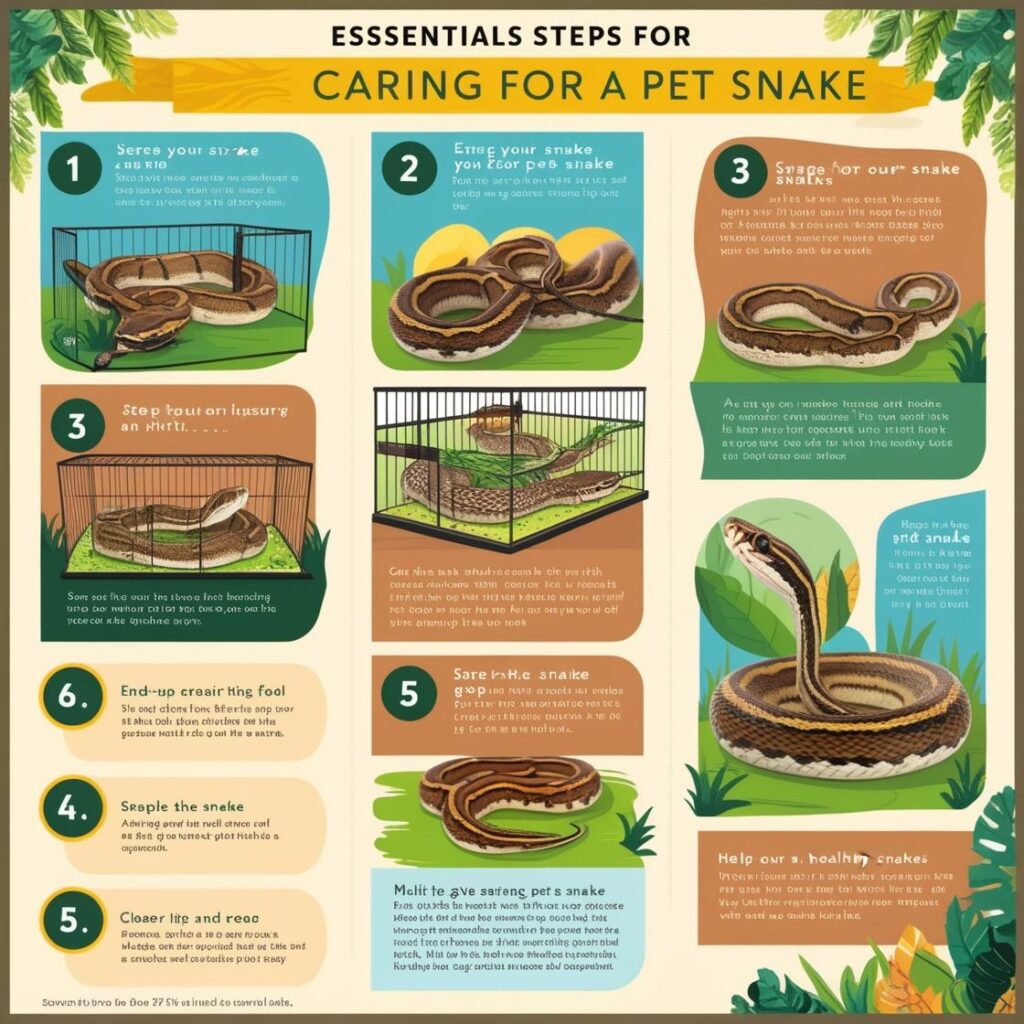Snakes, with their unique physical attributes, intriguing behaviors, and diverse species, have become increasingly popular as exotic pets. While having a snake can be a rewarding experience, it entails a significant level of commitment and knowledge. Proper care ensures that your reptilian companion lives a long, healthy, and fulfilling life. This guide aims to provide essential tips on how to take care of a pet snake, covering habitat, diet, handling, health, and more.
1. Selecting the Right Snake Species
Before acquiring a pet snake, it’s crucial to select the right species, as different snakes have varying needs and temperaments. Some popular beginner-friendly species include:
- Corn Snakes: Known for their docile nature and manageable size, corn snakes are ideal for first-time snake owners.
- Ball Pythons: This species is known for its gentle demeanor and wide variety of colorations. They require a slightly larger enclosure as they grow but are generally easy to manage.
- Garter Snakes: They are small, active, and relatively easy to care for, making them suitable for new owners.
Research the specific needs of the species you choose, including their size, lifespan, and any specialized care requirements.

2. Setting Up the Enclosure
Creating a comfortable and secure habitat is vital for your snake’s well-being. Here are the critical components of a suitable enclosure:
- Size and Type: Choose an appropriate-sized terrarium based on the adult size of your snake. A general rule is to have an enclosure that is at least one and a half times the snake’s length.
- Heating and Lighting: Snakes are ectothermic, meaning they rely on external heat sources to regulate their body temperature. A temperature gradient is essential; one side of the enclosure should be warmer (around 85°F to 95°F) while the cooler side should be around 75°F to 80°F. Use heat lamps, heat mats, and thermostat controls to maintain these levels. Normal light cycles with a day/night pattern should mimic their natural environment.
- Humidity: Depending on the species, humidity requirements can vary. Tropical snakes like ball pythons may require higher humidity levels (50% to 70%) compared to desert snakes such as the corn snake (30% to 50%). Use hygrometers to monitor humidity levels and mist the enclosure as needed.
- Substrate and Hiding Places: Use substrates like aspen shavings, coconut fiber, or reptile carpet, avoiding cedar and pine as they can be harmful. Provide hiding places using rocks, logs, or commercial hides to ensure your snake feels secure and reduces stress.
- Water and Accessories: Always provide fresh water in a shallow bowl that allows your snake to soak if desired. Include enrichment items like climbing branches or artificial plants to encourage natural behaviors.
3. Proper Feeding Protocol
Feeding your snake appropriately is crucial for its growth and health. Here’s how to ensure a proper diet:
- Prey Type and Size: Snakes are carnivorous and primarily eat rodents or, in some species, other animals like fish, birds, or insects. Ensure that the prey size is up to the width of the snake’s body at its widest point to prevent choking.
- Feeding Frequency: The frequency of feeding depends on the snake’s age and species. Hatchlings often require feeding every 5-7 days, while adults may eat every 1-2 weeks.
- Frozen vs. Live Prey: It’s recommended to feed your snake thawed, frozen prey rather than live animals to prevent injury to both your snake and the prey.
- Handling After Feeding: Allow your snake to digest its meal before handling it. A rule of thumb is to wait at least 48 hours post-feeding to prevent stress and regurgitation.
4. Routine Handling and Enrichment
Handling your snake is not only enjoyable but can also establish trust and reduce stress:
- Frequency and Method: Handle your snake gently and regularly—aim for at least once a week. When picking it up, support its body well to provide a sense of security.
- Avoiding Stressful Situations: Be mindful of your snake’s behavior and avoid handling during shedding periods or after meals to reduce stress.
- Enrichment Activities: Mimic natural behaviors through enrichment opportunities like allowing your snake to explore safely outside of its habitat (in secure spaces) or incorporating puzzle feeders.
5. Health Monitoring and Veterinary Care
Maintaining your snake’s health involves regular monitoring and understanding the signs of illness:
- Regular Observations: Monitor your snake for signs of distress, such as lethargy, changes in appetite, abnormal shedding, or unusual behavior. Regularly check for mites or signs of respiratory infections, such as wheezing or discharge from the mouth and nostrils.
- Veterinary Care: Establish a relationship with a veterinarian who specializes in reptiles. Schedule health check-ups annually, and take your snake for immediate attention if you notice any signs of illness.
- Preventative Measures: Maintain cleanliness in the enclosure, providing fresh water and removing waste promptly. Quarantine new snakes to prevent disease transmission.
6. Long-Term Commitment
Owning a pet snake is a long-term commitment, often spanning several years or even decades, depending on the species. Ensure that you are prepared for the responsibility, including the financial aspects of veterinary care, feeding, and housing.
Conclusion
Caring for a pet snake can be a fulfilling experience that allows you to engage with one of nature’s most fascinating creatures. By understanding the specific needs of your snake and providing the right environment, diet, and care, you can foster a strong bond with your pet while enhancing its quality of life. With commitment and knowledge, both you and your snake can thrive together, enjoying the unique joys that come from sharing your life with this extraordinary companion.